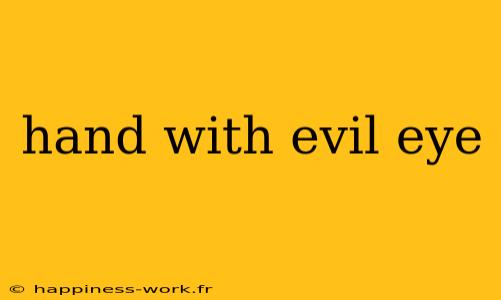The hand with the evil eye is a powerful symbol that transcends cultures and carries deep meanings. Often recognized for its protective qualities, it is an emblem that can be seen in jewelry, art, and various forms of decor. This article delves into the significance of the hand with the evil eye, exploring its history, symbolism, and how it is perceived in different cultures.
What is the Evil Eye?
The evil eye, known as mal de ojo in Spanish and nazar in Turkish, is a concept believed to bring misfortune or harm to individuals through envious glares or malevolent thoughts. The belief in the evil eye spans thousands of years and is present in various cultures, including Middle Eastern, Mediterranean, and South Asian societies.
Historical Context
Historically, the evil eye has been depicted in various forms, with artifacts dating back to ancient civilizations such as the Greeks and Romans. People have used amulets, talismans, and protective charms featuring the evil eye to ward off negativity. The hand symbol, often referred to as the "Hand of Fatima" or "Hamsa," serves as an additional layer of protection against the malevolent forces associated with the evil eye.
What Does the Hand with the Evil Eye Symbolize?
The hand with the evil eye typically combines the protective qualities of the Hamsa hand with the all-seeing eye, providing a potent symbol of protection, blessings, and power. Here are some key interpretations:
-
Protection: The hand shape is thought to repel negative energy and evil intentions. It acts as a shield for the wearer, guarding against jealousy and harm.
-
Blessings and Power: The eye symbol represents insight and awareness. Together with the hand, it signifies that one is always watched over and under divine protection.
-
Unity of Feminine and Masculine Energies: The Hamsa is often associated with femininity, while the evil eye is linked to both genders. Together, they embody a balanced union of energies.
How is the Symbol Used in Daily Life?
The hand with the evil eye is widely incorporated into fashion and design. Here are a few ways to integrate this powerful symbol into daily life:
-
Jewelry: Many wear bracelets, necklaces, or rings featuring the hand with the evil eye as a fashionable accessory that also serves as a talisman.
-
Home Decor: Incorporating this symbol into home decor, like wall hangings or decorative plates, can create a protective atmosphere.
-
Gifts: The hand with the evil eye is a popular gift, often given to friends and family to wish them protection and good fortune.
Practical Examples of Usage
-
Personal Jewelry: An individual may wear a necklace with a hand and evil eye symbol during significant life events, such as graduations or weddings, to attract positive energy and protection.
-
Interior Design: A person may display a hand with an evil eye on their entryway wall to guard their home from negative vibes and bad intentions from visitors.
Conclusion
The hand with the evil eye is a multifaceted symbol that serves as both a fashion statement and a protective amulet. Its rich history and widespread use reflect its significance in various cultures. As we navigate an increasingly complex world, the desire for protection and positivity remains universal. By incorporating the hand with the evil eye into our lives, we not only embrace a meaningful tradition but also create a space for blessings and shield ourselves from negativity.
Further Reading
-
Explore more about the Hamsa Hand and its origins on WikiHow.
-
Investigate the Evil Eye's Cultural Significance through resources available online and in libraries for deeper insights into its transformative power.
By understanding and embracing the hand with the evil eye, we connect with a rich tapestry of beliefs and customs that offer protection, blessings, and a sense of belonging across cultures.
This article is inspired by information from WikiHow. Special thanks to the original authors for providing valuable insights on cultural symbols and practices.
